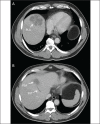Streptococcus anginosus pyogenic liver abscess following a screening colonoscopy
- PMID: 24421818
- PMCID: PMC3720014
- DOI: 10.1155/2013/802545
Streptococcus anginosus pyogenic liver abscess following a screening colonoscopy
Abstract
A previously healthy 58-year-old man presented with a septic thrombosis of the right hepatic vein and a pyogenic liver abscess (PLA) one week after undergoing a screening colonoscopy. Blood cultures and a radiological drainage specimen were both positive for Streptococcus anginosus. Evolution was favourable after six weeks of antibiotherapy. To the authors' knowledge, the present report is the first to describe a PLA following a screening colonoscopy with no intervention. The authors hypothesize that silent microperforations during colonoscopy contributed to the infection. Although 20% to 40% of reported PLA cases are cryptogenic in the literature, it may be because of failure to recognize and report a precipitating factor such as colonoscopy. As more cases similar to the present case are reported, the number of cryptogenic cases may decrease.
Un homme de 58 ans auparavant en santé a consulté en raison d’une thrombose septique de la veine hépatique droite et d’un abcès hépatique à pyogènes (AHP), une semaine après une coloscopie de dépistage. Les analyses sanguines et l’échantillon de drainage radiologique étaient tous deux positifs au Streptococcus anginosus. L’évolution était favorable après six semaines d’antibiothérapie. En autant que le sache les auteurs, le présent rapport est le premier à décrire un AHP après une coloscopie de dépistage sans autre intervention. Les auteurs postulent que des microperforations silencieuses pendant la coloscopie ont contribué à l’infection. Même si de 20 % à 40 % des cas d’AHP déclarés sont de nature cryptogénique dans les publications, ce peut être en raison du défaut de dépister et de signaler un facteur précipitant comme la coloscopie. À mesure que plus de cas similaires à celui présenté seront signalés, le nombre de cas de nature cryptogénique pourrait diminuer.
Keywords: Abscess; Colonoscopy; Pyogenic liver; Streptococcus anginosus; Streptococcus milleri group.
Figures
References
-
- Johannsen EC, Sifri CD, Madoff LC. Pyogenic liver abscesses. Infect Dis Clin North Am. 2000;14:547–63. - PubMed
-
- Meddings L, Myers RP, Hubbard J, et al. A population-based study of pyogenic liver abscesses in the United States: Incidence, mortality, and temporal trends. Am J Gastroenterol. 2010;105:117–24. - PubMed
-
- Kaplan GG, Gregson DB, Laupland KB. Population-based study of the epidemiology of and the risk factors for pyogenic liver abscess. Clin Gastroenterol Hepatol. 2004;2:1032–8. - PubMed
-
- Petri A, Höhn J, Hódi Z, Wolfárd A, Balogh A. Pyogenic liver abscess – 20 years’ experience. Comparison of results of treatment in two periods. Langenbecks Arch Surg. 2002;387:27–31. - PubMed
-
- Corredoira, et al. Prospective study of Streptococcus milleri hepatic abscess. Eur J Clin Microbiol Infect Dis. 1998;17:556–60. - PubMed
Publication types
LinkOut - more resources
Full Text Sources
Other Literature Sources
Research Materials


